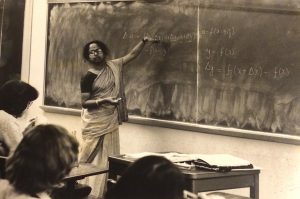I am often asked to describe my career as a woman in analytics and provide some insights to guide women who wish to be part of this field and to succeed as leaders in the profession. I have divided my comments on women in analytics into sections, starting from the beginning, namely, how do you even encourage a young girl to enter a field that has been largely viewed as dominated by men?
Getting an early start in Analytics
How do you encourage a young girl to pursue a career which requires mathematical or scientific skills? How do you react to your child’s interest in mathematics? Do you react differently depending on whether the child is a boy or girl? Why? Encourage him / her to pursue that interest and ensure that the school is emphasizing that message as well. From my childhood, my parents (especially my dad who started his career as a Math professor) were very proud that I was good at math – no one ever commented on the fact that I was also a girl! When I started high school and ended up being the only girl in the math class, we took it in stride and did not make a big deal of it – Radhika likes math and she is in the math class. That was it!
One way to interest young girls in math-related fields is by providing examples of real-world applications so they can understand the value. In today’s world, every field is rich with applications of mathematical modeling, so it is easier to capture student’s interests. Another avenue is to encourage your child to participate in competitions, especially ones involving teams. Often, girls like working in teams which can also be good training for their professional career later in life.
And, of course, it is very important for the young girls to have role models of women in analytics who provide examples of successful careers in these fields.
Personal experience

I had a unique experience during my Master’s program in Mathematics at the Indian Institute of Technology in Delhi. It was amazing that in the year 1975, my class had 7 women out of the small class of 14 students! Several of us women have gone on to have very successful professional careers in highly technical fields – in fact three of us are now in the U.S. Likewise, my PhD class in Operations Research at Cornell had five women out of a total of about a dozen students. With that kind of an experience of women in analytics, I have never noticed that there may be more men than women in my field. We are all just members of the analytics community!
Career Growth
Women are hesitant to talk about their strengths and proactively seek promotions. Be bolder in seeking out new opportunities. Of course, you need to be qualified for the role! Be confident of your strengths. If you have a strong foundation and are the expert in your area, your being a woman in analytics is irrelevant. People will recognize you as the expert immediately. Be bold and take a seat at the table. If you have been invited to participate, it is because you are recognized as someone who can contribute – use that opportunity to do so.
Women in Analytics professions
Within SAS Institute, we have several women in analytics at all levels – from individual contributors who are recognized throughout the institute as “the expert in a particular area” to senior managers who are responsible for key flagship analytical products from SAS. Several of them play important roles in leading professional organizations in addition to their responsibility at SAS. As a percentage of the workforce, we may have fewer women than men in the industry as a whole. However, there are several women in leading roles in analytics, both as leaders in major multinational companies (IBM, Ford, Verizon) and at the helm of professional organizations like the Institute for Operations Research and Management Science (INFORMS), the American Statistical Association, etc.
Especially in the last few years, women in analytics have made great strides in leading large organizations. For example, Dr. Pooja Dewan was named Chief Data Scientist at BNSF, Malene Haxholdt is VP of Enterprise Analytics at Metlife, Dr. Nipa Basu is Chief Analytics Officer at Dunn and Bradstreet and so on.
There is a geographic differential in the representation of women in technology. Some of the research from the UK indicates that women in India seem to see IT/STEM as empowering in a way that women in the UK or US do not. There is also research suggesting that while women may not be doing well in terms of increased numbers in computer science or math the discipline of statistics is an exception: “More than 40 percent of degrees in statistics go to women, and they make up 40 percent of the statistics department faculty poised to move into tenured positions.”
Increasing interest in analytics for women
As analytics and data science become more ubiquitous in several industries, we are seeing an increase in the number of women in Analytics. There are a few key reasons for this increase:
- There are many applications areas for analytics which are attractive to women: Health care, Education, non-profit work, projects that are aimed at doing social good. There is ample evidence that women are more drawn to opportunities to make a social impact.
- More companies are providing flexibility that helps women get back or stay in the work force. These include benefits like flexible work schedules, more “work from home” options, family medical leave options, more options for day care, support for nursing mothers, and so on.
- Many educational opportunities are available for women to get trained in data science and analytics arenas through online master’s programs or certification programs. For women who have a STEM-related undergraduate education, this provides an easy entry into the analytics domain. There is an interesting article describing how data science is creating opportunities for women. It is exciting to see the many women leaders who participated in the recent Women in Data Science Conference where the elite panel of speakers were all women!
- Many collaborative, team competitions (for example, the DataDive at SAS being held in partnership with DataKind) are being arranged across the data science and analytics domain – such collaborative, problem solving events may be particularly appealing to women.
Challenges and opportunities being a woman in this highly competitive field
It is well recognized that there is a confidence issue that plagues women in fields that are dominated by men. A Harvard study presented the result: “Female computer science concentrators with eight years of programming experience report being as confident in their skills as their male peers with zero to one year of programming experience.” I can relate to that! Most women I know will speak up only if they are confident that their points are thoroughly researched and vetted. We need to encourage them to participate freely in any dialog and discussion. Women need to be reminded that they have been invited to be in the group / discussion because their opinions are valued.
 At the same time, women have some inherent strengths that they bring to the table. We have an ability to understand others’ points of view which makes it possible to have productive discussions over contentious topics. We also have a capacity to nurture which is useful in growing a team of very talented individuals who are often brilliant but may not be used to working as part of a high achieving team. One of the most important skills for a successful leader is the ability to see the big picture (remember the tale of the “Six Blind Men and the Elephant?” I believe that women are more likely to understand the big picture because of their natural empathy for others’ inputs.
At the same time, women have some inherent strengths that they bring to the table. We have an ability to understand others’ points of view which makes it possible to have productive discussions over contentious topics. We also have a capacity to nurture which is useful in growing a team of very talented individuals who are often brilliant but may not be used to working as part of a high achieving team. One of the most important skills for a successful leader is the ability to see the big picture (remember the tale of the “Six Blind Men and the Elephant?” I believe that women are more likely to understand the big picture because of their natural empathy for others’ inputs.
My advice to young women entering the field of analytics is: Do not hold yourself back because you are a woman, you have earned the right to be in this area, use your strengths to build a strong team by nurturing everyone’s talents. This is a golden age to be part of this domain!
Image credit: photo by Mike Kline // attribution by creative commons
Note: I prepared these thoughts related to an interview in Analytics India Magazine: International Women's Day special.







3 Comments
Hi Radhika - Much thanks for the very inspirational story!
Set my mind dreaming enthusiastically for my 4 year old daughter 🙂
Great article Radhika. It sensitively highlights the importance of diversity and respecting different strength within an organisation. I particularly like the reference to team work and the progress that can be made when working towards a common goal with a strong sense of the bigger picture.
Thank you, Radhika, for this insightful article! I can relate to so much that you say here.